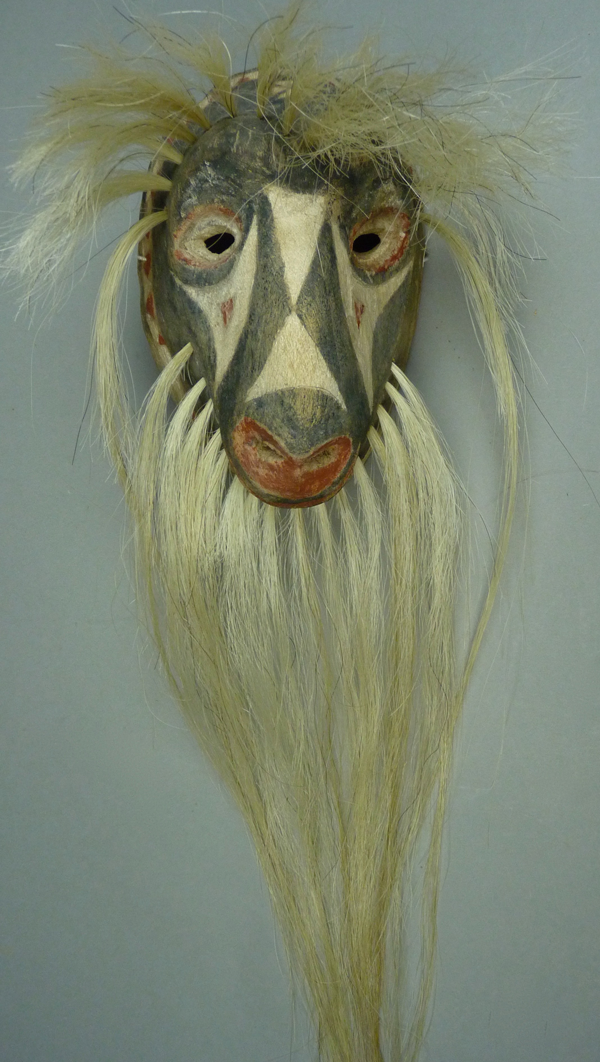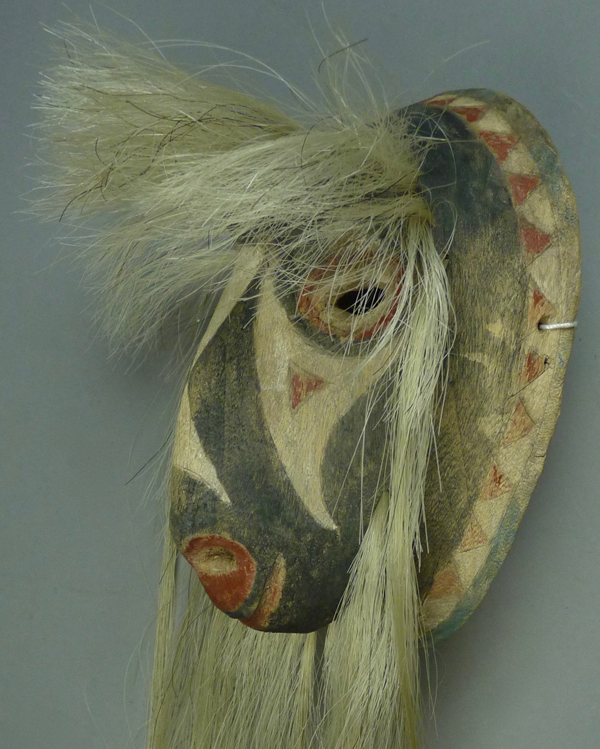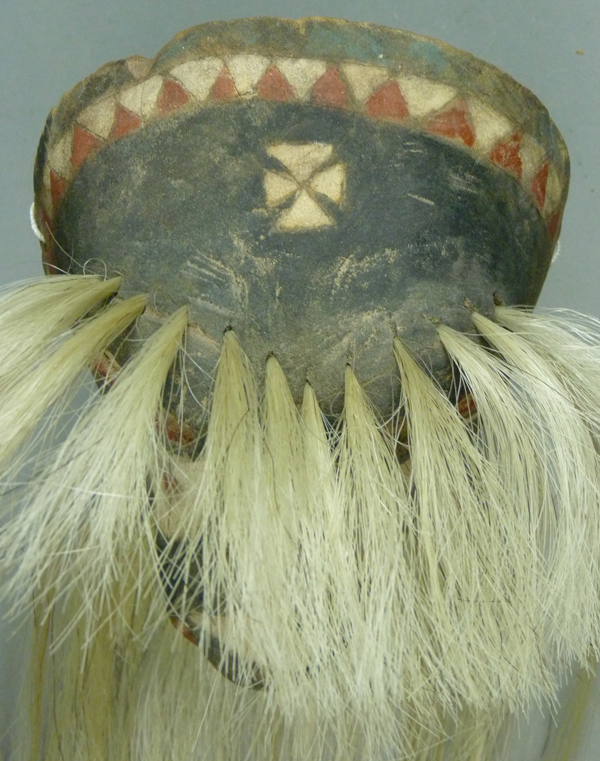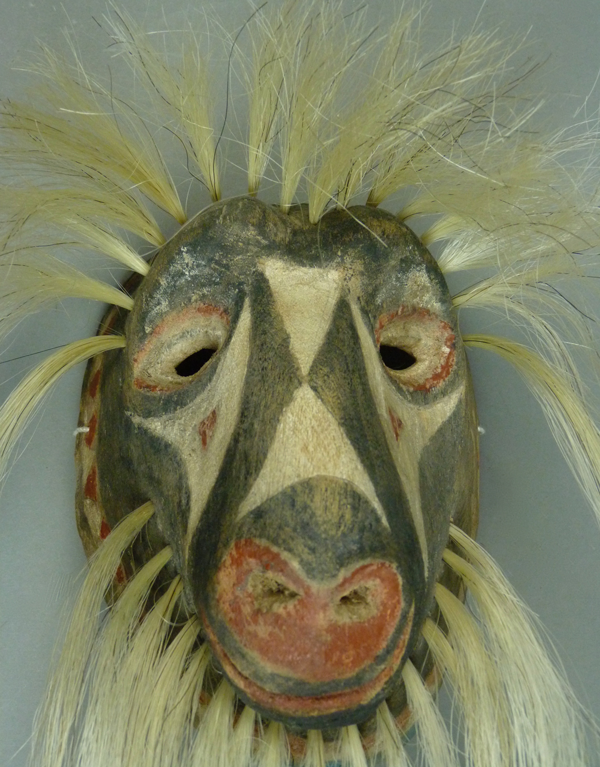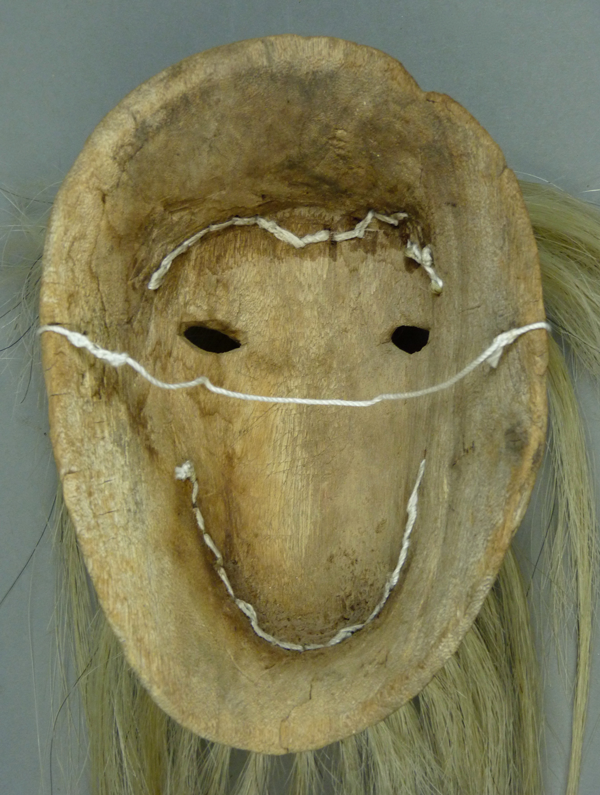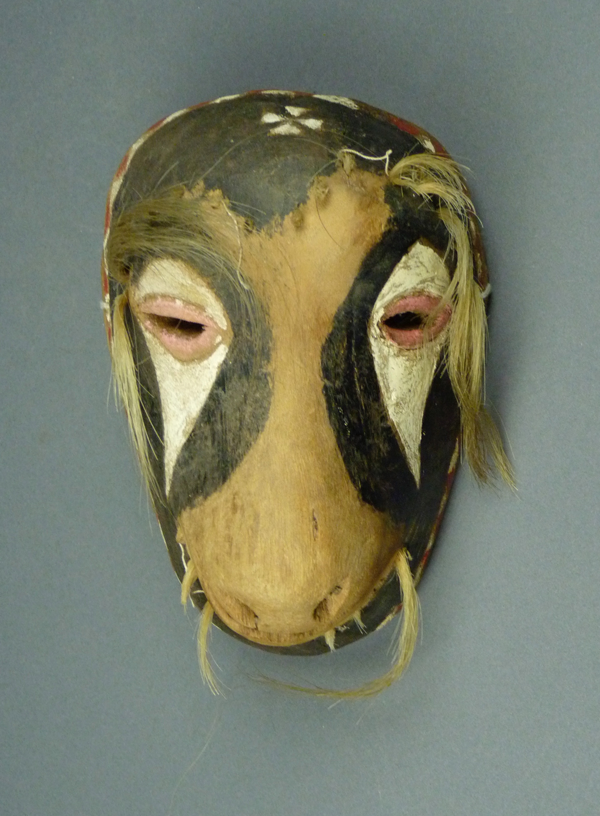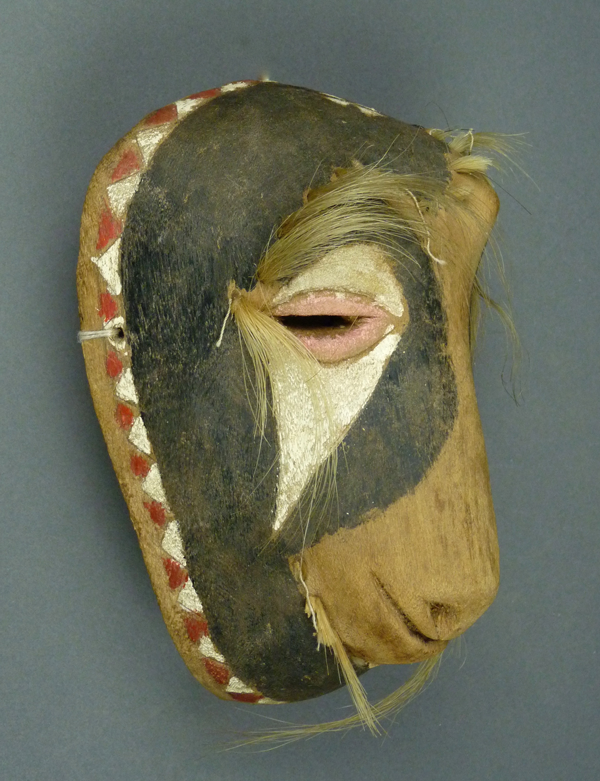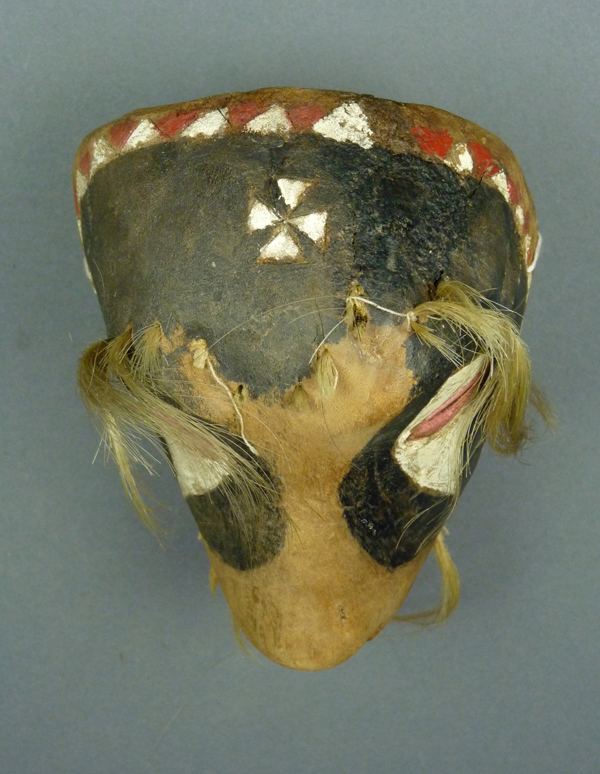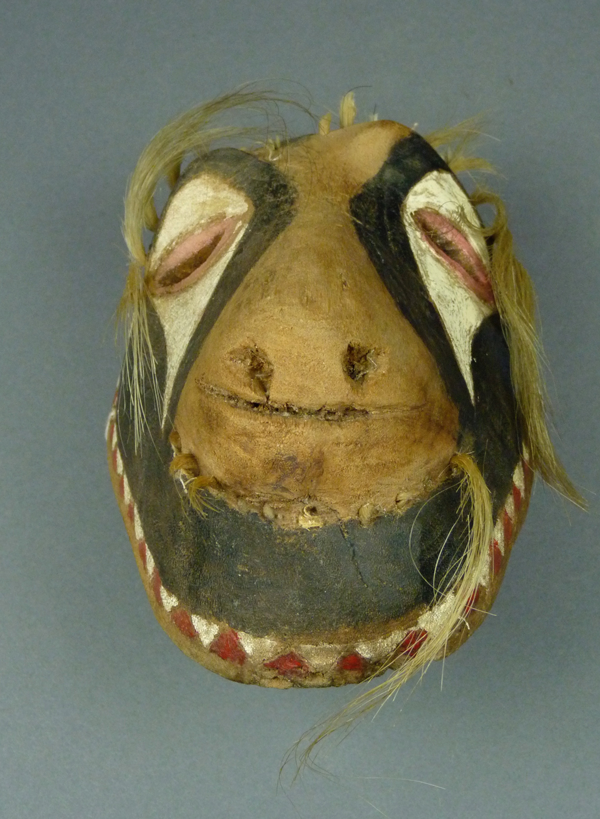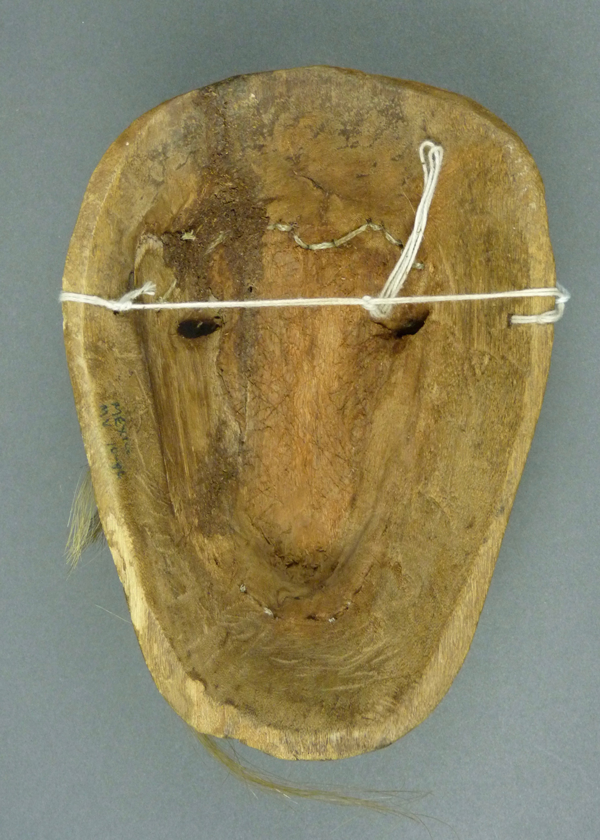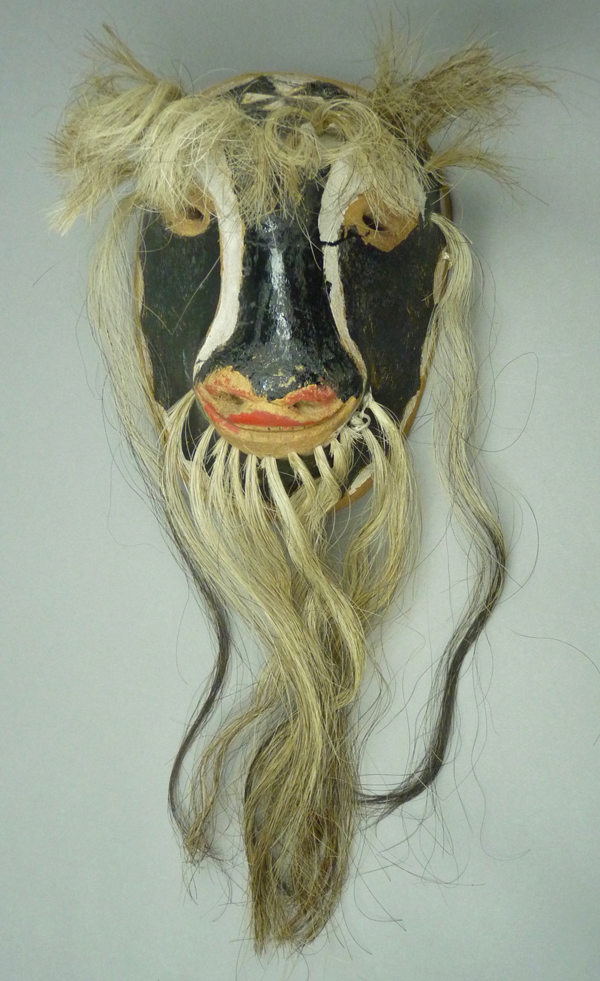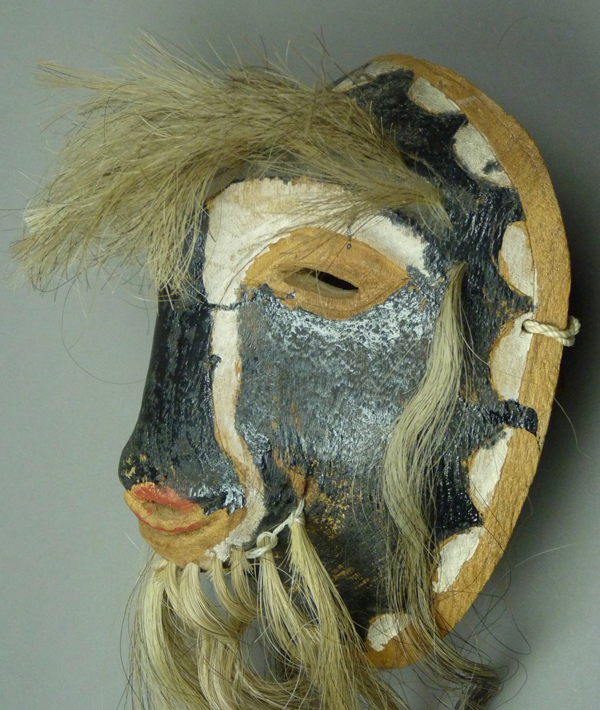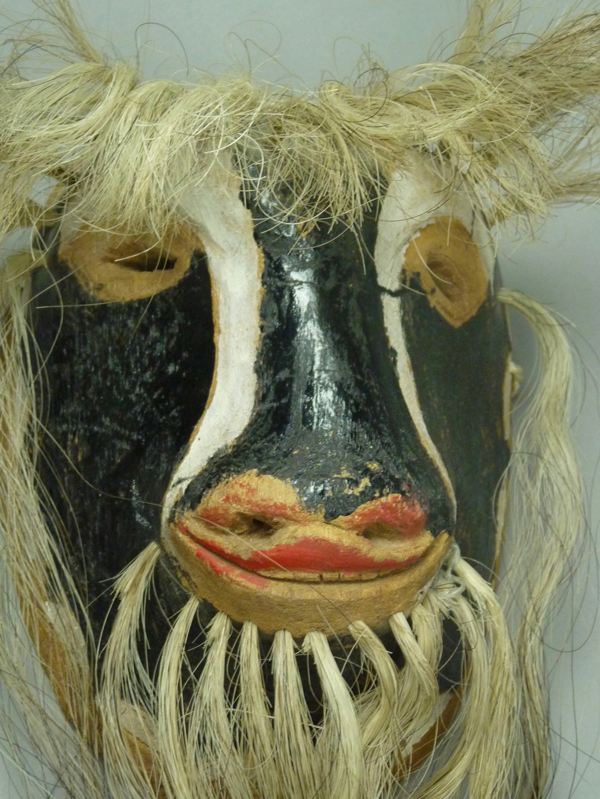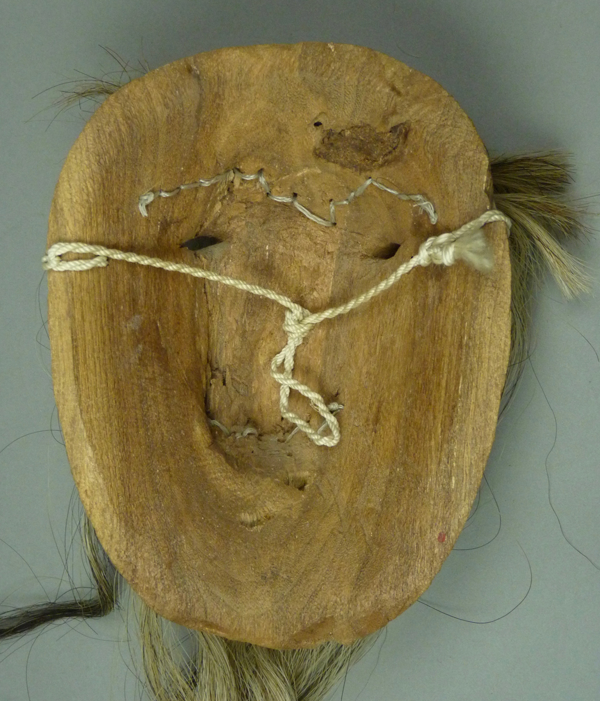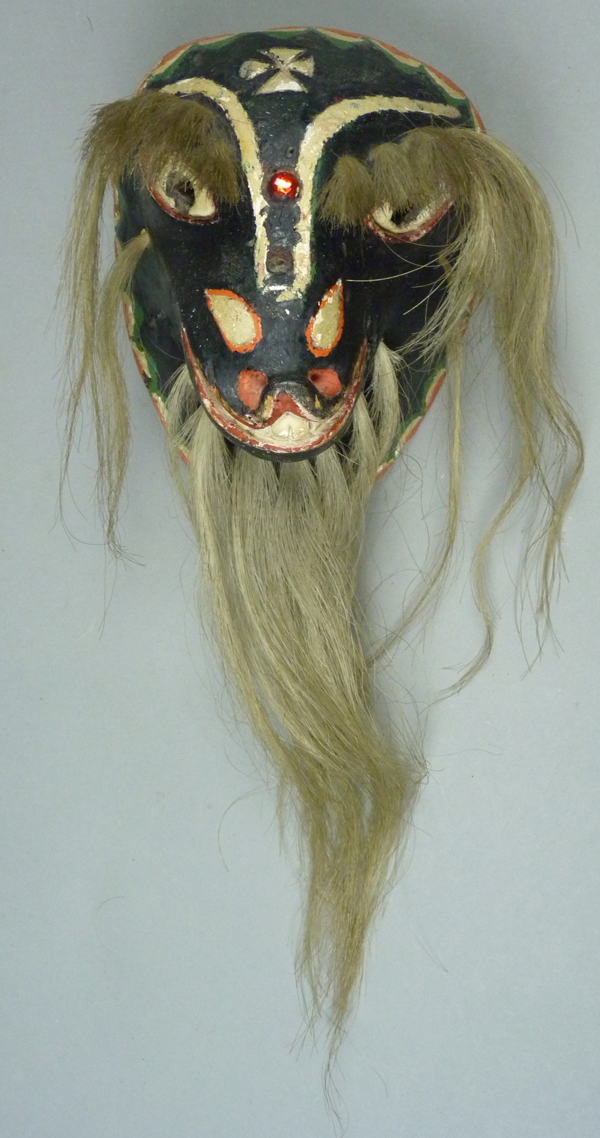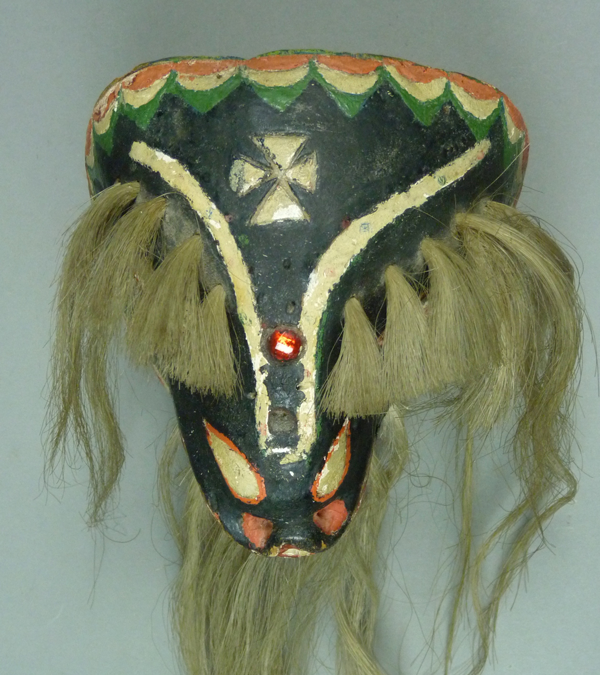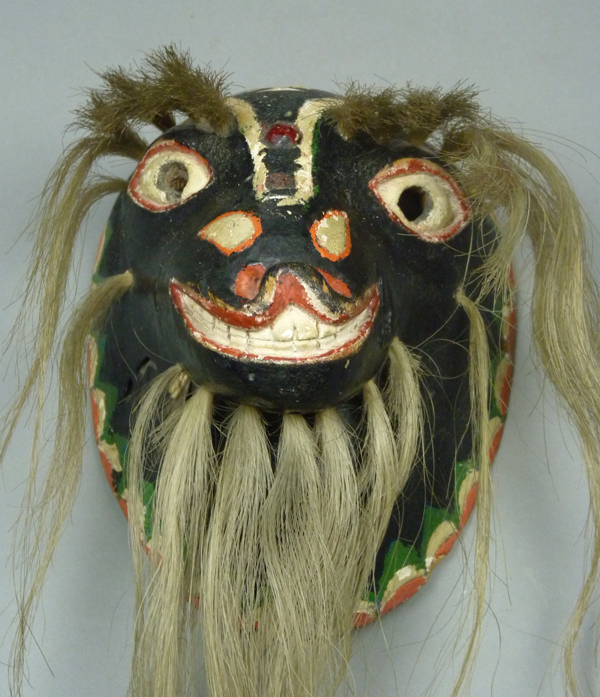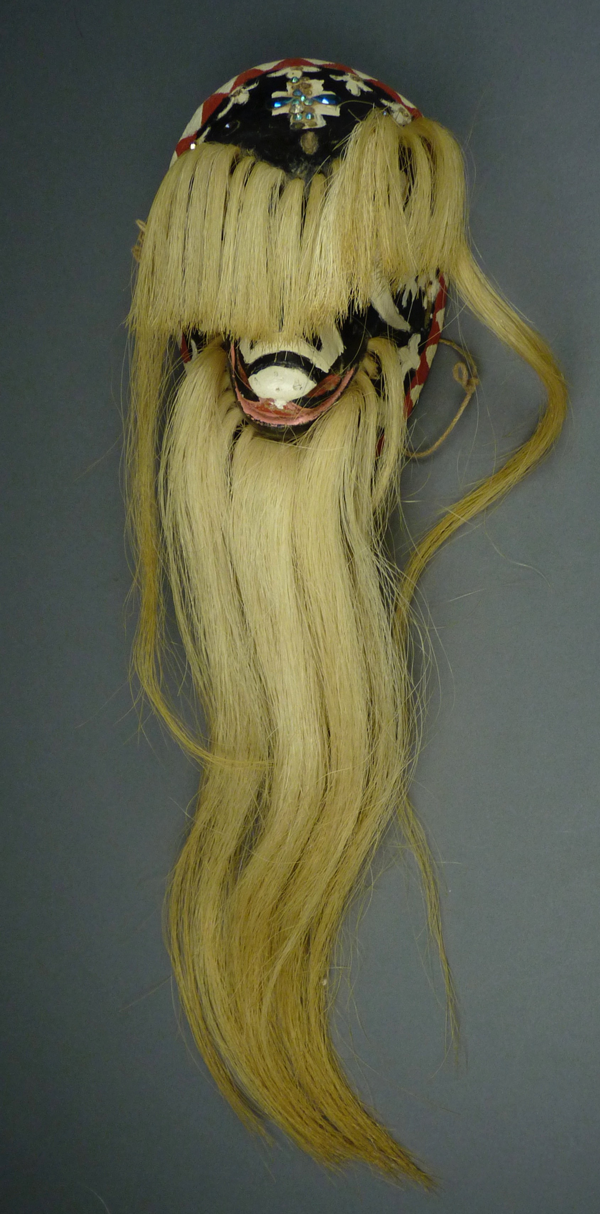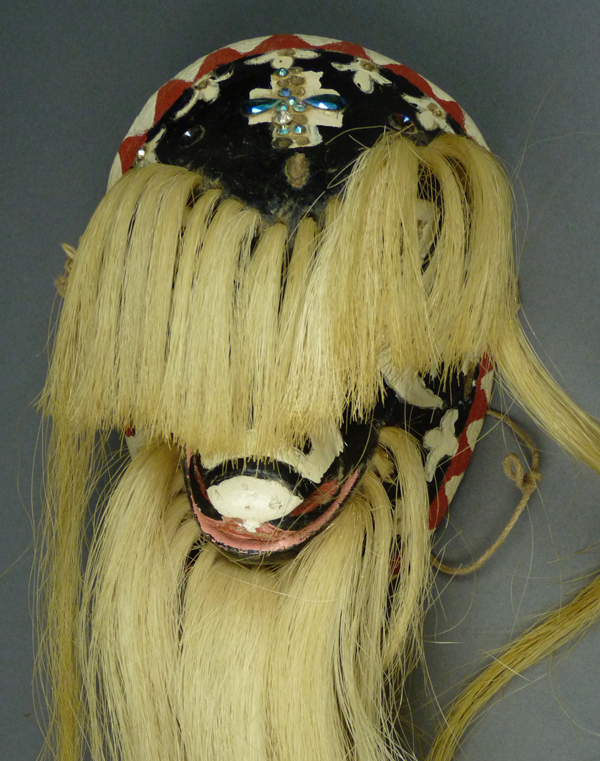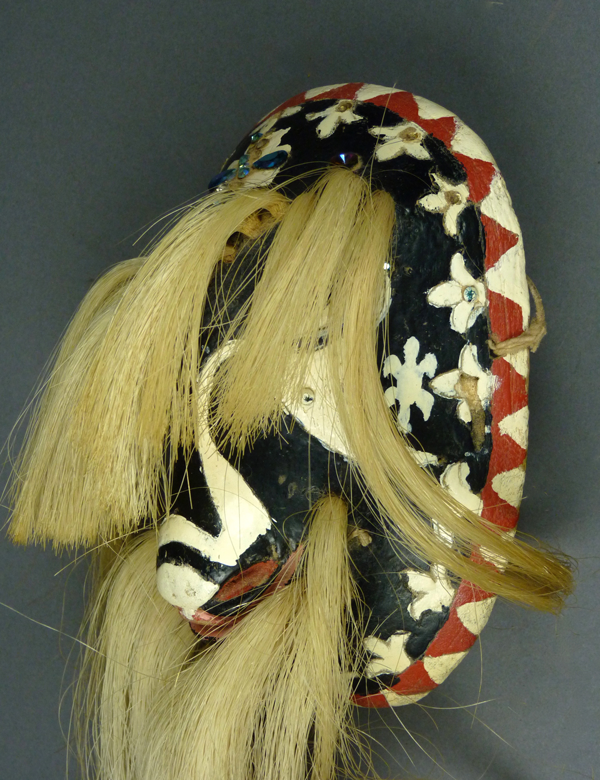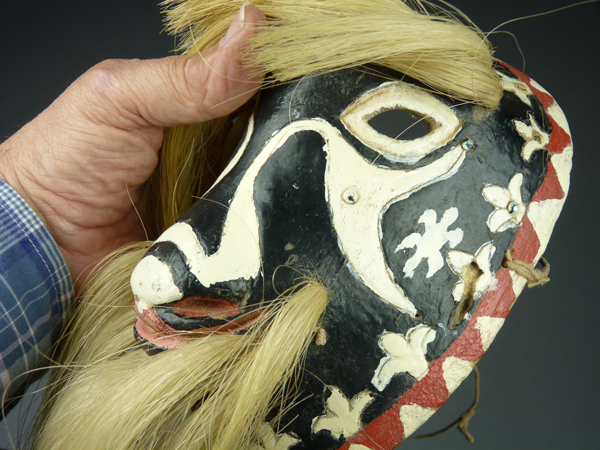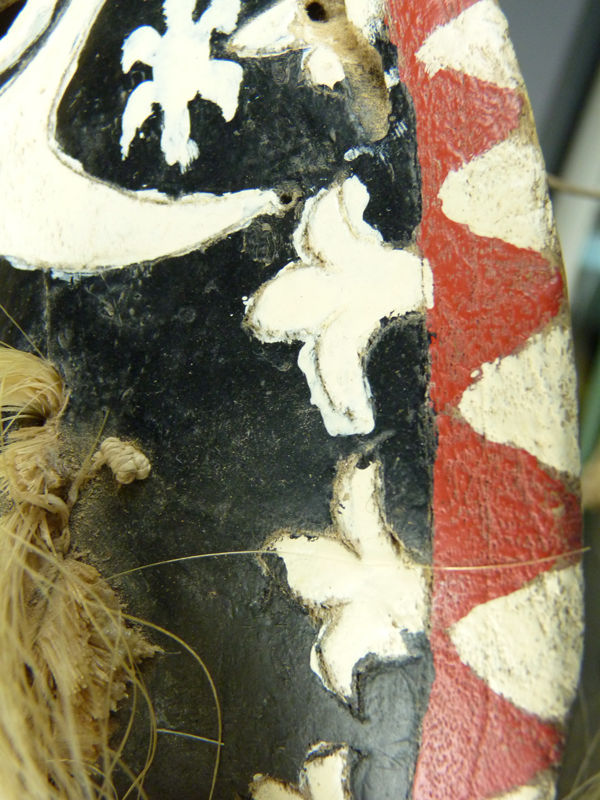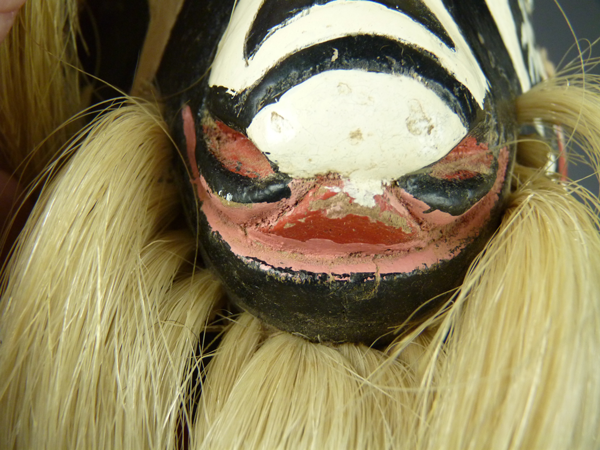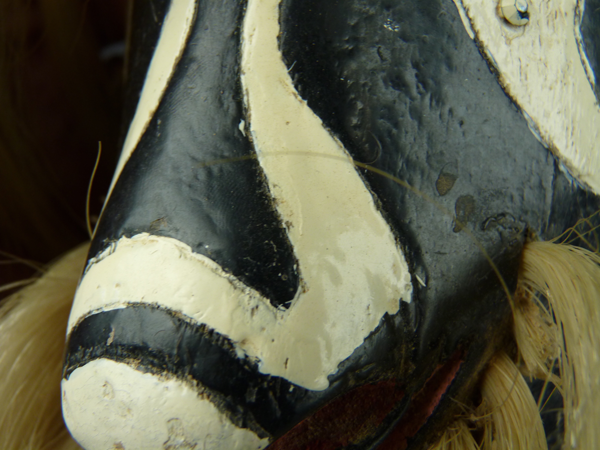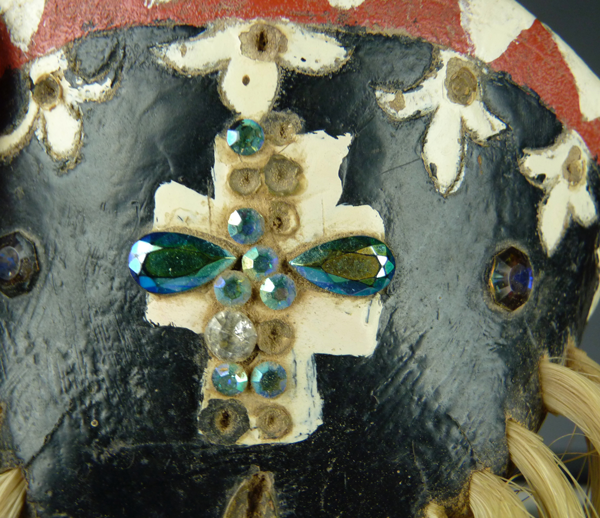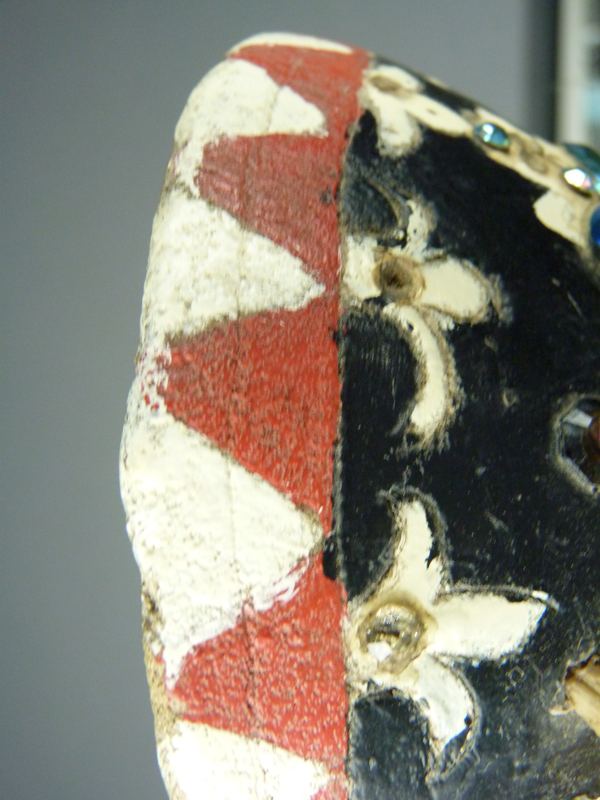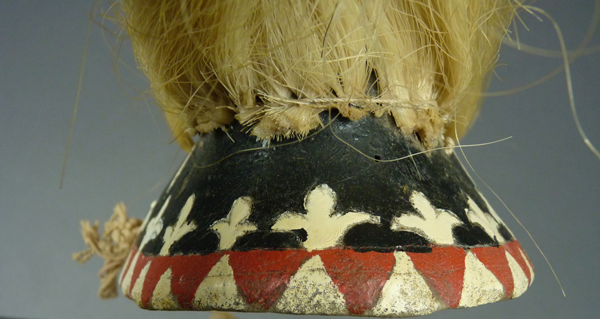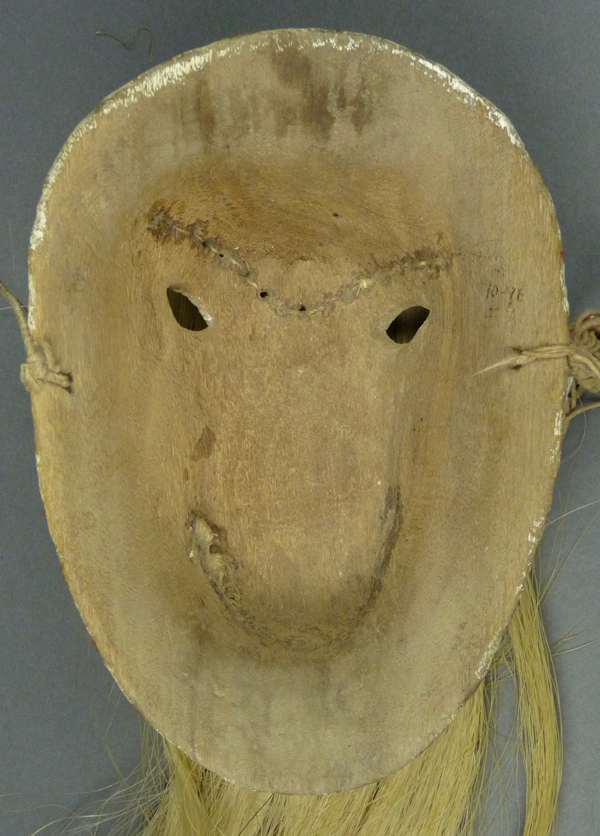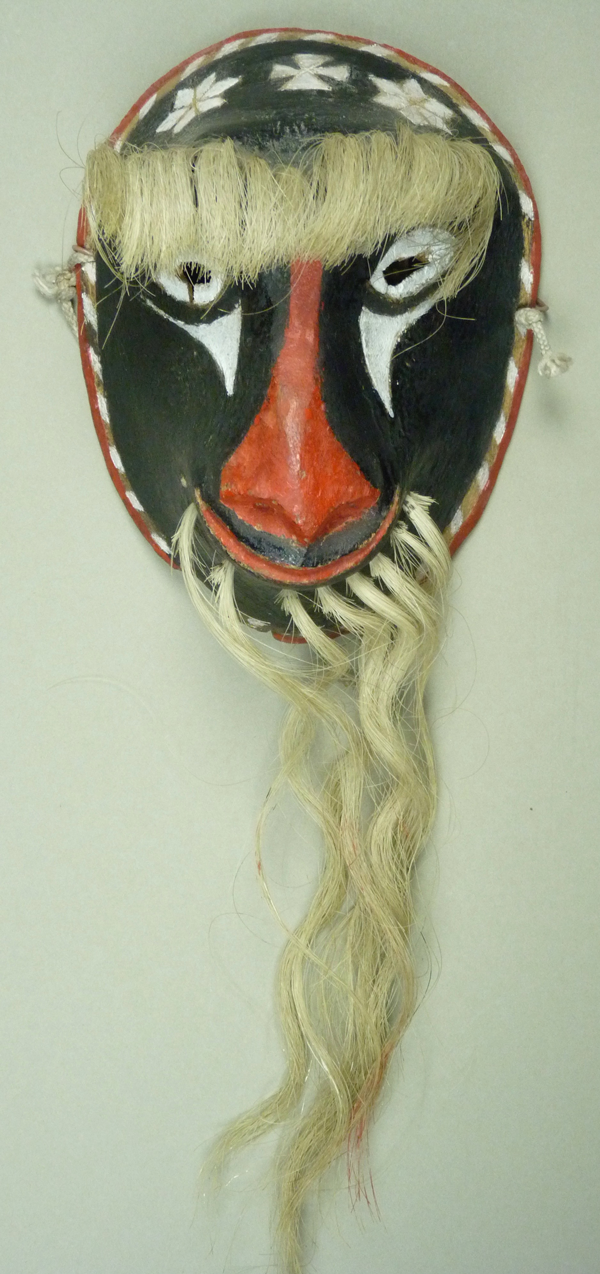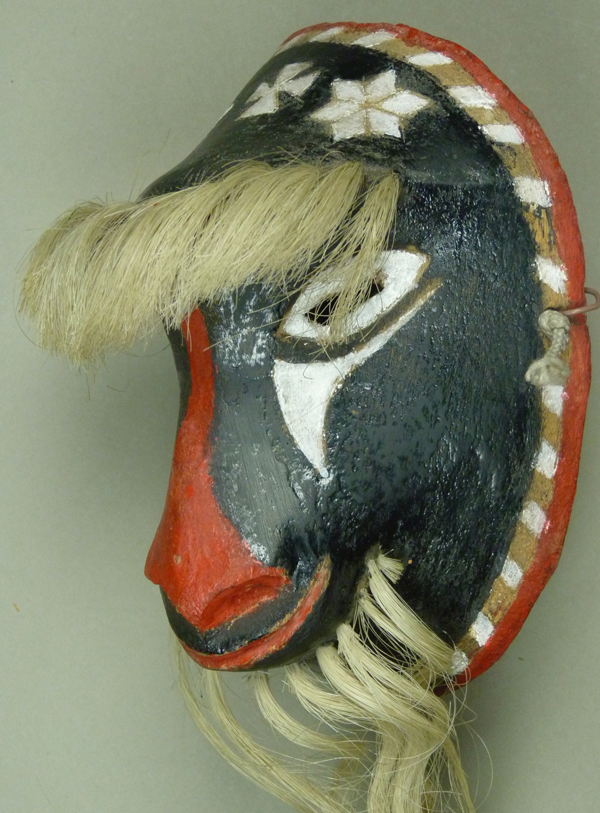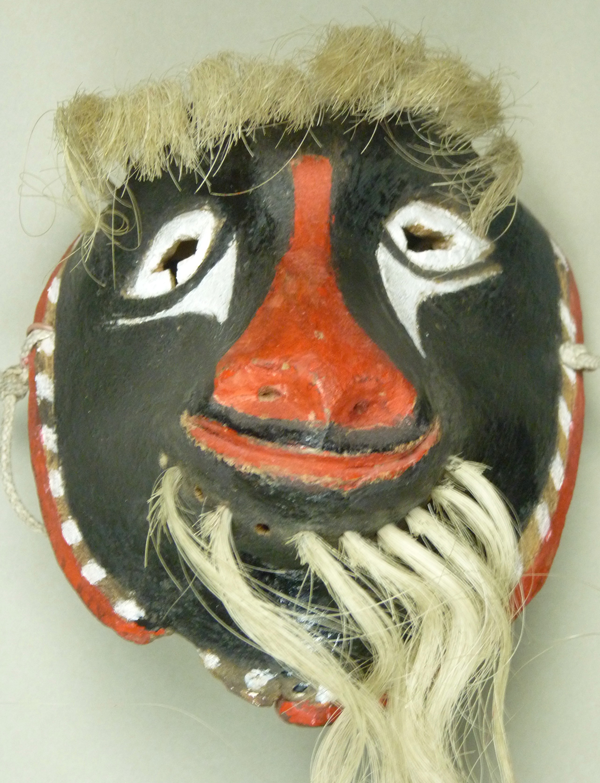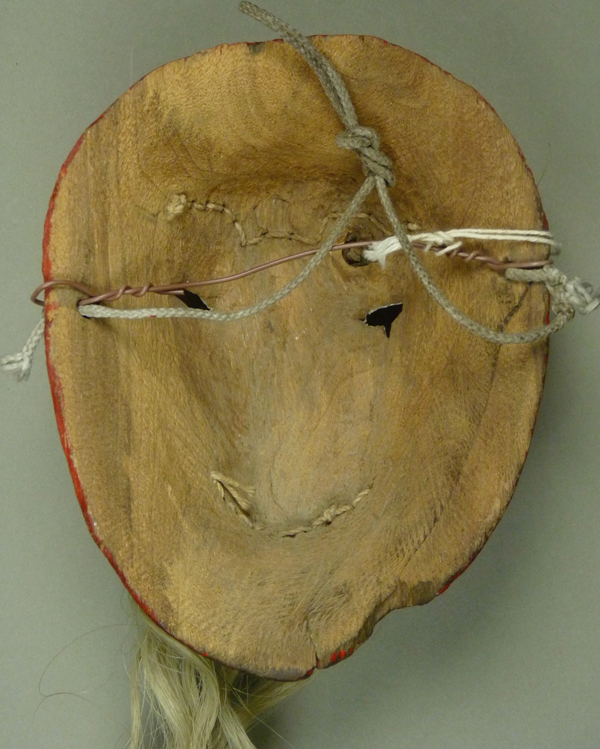Today we will examine goat faced Pascola masks that were carved by Manuel Centella Escalante, beginning with the mask I had told you about in my earlier post of 11/16/2016, one of those that was discovered in the house of Lino Suarez, the principal Pascola at Old Pascua, just before the bulldozer arrived to demolish the place. The mask was weathered and insects had consumed the hair, but it was otherwise intact. It was later re-haired by David Valenzuela. Here is that goat mask.
I thought that I would wash some of the dust off this mask with a moist rag. To my shock, I immediately discovered that the white paint was water soluble! This may have contributed to the severely weathered appearance of this mask. But on the other hand, there is more than enough of the original paint left to reveal the beautiful painted designs on the face.
The original rim design, so typical of Manuel Centella, remains, but there are only faint traces of the painted triangles over the eyes. The white triangles under the eyes have the inscribed border of an inner triangle that was painted red. All this is classic for Manuel Centella’s Pascola masks.
The forehead cross is likewise intact and typical.
Look at the shaping of the mask above the eyes. In contrast to his human faced masks, Centella’s goat masks rarely if ever have a chin cross.
This mask is 7½ inches tall, 5¼ inches wide, and 3½ inches in depth.
The back is heavily weathered, in sharp contrast to the new white string used by David Valenzuela to install replacement hair.
The second mask, collected in Sonora by Barney Burns and Mahina Drees in 1986, demonstrates what happens when a mask painted with water soluble paint is exposed to excess moisture. I believe that most if not all all of the tan area over the muzzle was once painted white. This mask came with the following history: collected from “Manuel Valenzuela, used for 50 years, he died in 1983.” In other words, this mask was allegedly created in about 1933. However, it is my impression that Yaqui goat faced Pascola masks did not emerge until the late 1930s, so I suspect that this “50 years” history is an exaggeration. From this photo alone the identity of the carver is already obvious. Stylistically, this would seem like a Centella mask from the 1950s or 60s.
Indeed, this mask is very little different from the first in today’s post.
This is such an old mask to have such a clear signature (cross) on the forehead.
There is no evidence of a chin cross.
On the back is a notation by Barney Burns and Mahina Drees—”Mexico, MV, 10/96″—indicating their impression that Manuel Valenzuela was the carver. But of course this mask was carved by Manuel Centella.
I bought the next mask from Tom Kolaz in 1993. I felt lucky to get it, as this too was said to have belonged to Lino Suarez. The decoration on this mask permits an interesting observation—Centella seemed to become freer and more experimental when he shifted from human faced masks to those depicting animals. For example, the white triangles over the eyes are gone, but they have been replaced by these sweeping white lines that extend from the corners of the mouth to the spaces over the eyes. Like many other decorative elements on his masks, these shapes were carefully outlined with inscribed lines.
The curled upper lip is a design detail that Centella used on some of his goat faced Pascola masks. Soon I will soon show you other examples.
From this view we see a classic Centella Pascola mask.
The original cross has been covered with applied triangles; this was probably done by a dancer (and perhaps by Lino Suarez). The slender crescent shaped painted brows on the forehead are also characteristic Centella decorative elements, and these lie above the shapes that rise from the corners of the mouth and curl under the brow hair.
In the next photo, note this enhanced view of the curling upper lip, and the tiny teeth that resemble those on Centella’s monkey or ape masks.
Look again at these graceful curling white elements that stretch from the eyes to the corners of the mouth.
This mask is 8 inches tall, 6 inches wide, and 3½ inches in depth.
The staining on the back suggests considerable wear.
I found the next goat Pascola mask on EBay™, back in 2009. The upper lip is curled so high that the two front teeth are showing!
The forehead cross and the rim design left little doubt about the identity of the carver.
This time the sweeping white lines meet on the muzzle.
Here s a closer view of this curled lip.
There is an applied red plastic jewel on the muzzle, and below it a hollow spot where another jewel has fallen off.
This mask is 7 inches tall, 5¼ inches wide, and 4 inches in depth.
The back of this mask is heavily stained, following long use.
The next mask is another from the Barney Burns and Mahina Drees collection. It was collected as an anonymous mask in 1986, after 10 years of use. Mahina Drees had informed me that she and Barney were unaware that there were any masks in their collection by Manuel Centella Escalante. It turned out that they owned several unidentified or mis-identified Yaqui Pascola masks that were by this carver, and this is the seventh Centella mask from their collection that I have been pleased to include in these Centella posts. Of all those masks, this one is probably the most exotic and the most difficult to spot. At the same time, I would say that it is one of the best.
The quality of the brow and chin hair is one clue that we are dealing with a master carver.
The generic rim design of triangles has probably been modified in the course of repainting. The freehand painted element on the cheek (sun, flower, or turtle?) was probably added later.
These detail photos are included to emphasize two observations. First, the conventional rim design has been augmented with these fluer-de-lis forms, which strike me as particularly elegant. It is clear that these elements do not represent afterthoughts, as they are outlined by inscribed lines as was usual for Centella, and they remind me of his “drapery style” rim design that I showed you in recent posts. Second, just look at what the carver has done with the usual white triangles under the eyes—these have been integrated with other lines over the muzzle.
The resulting abstract shape is outlined by inscribed lines, for another elegant touch.
The following photo provides a close-up view of a curling tongue or upper lip.
Sloppy repainting obscures the details of this last photo.
Here is another view of the muzzle with its inscribed lines.
The forehead cross has been dramatically re-designed, and the inscribed lines that defined the original forehead cross are only faintly visible. On the other hand, one can see a plethora of applied plastic “gems” along with other former sockets for jewels that have been lost.
This is one of several photos that seem to show an inscribed line down the middle of the rim design, suggesting that it might once have had quite a different appearance.
There is no evidence for a chin cross, but this conforms to the observed pattern that none of Centella’s goats have chin crosses.
There is a date of collection on the back of this mask, which I am reading as 10-86, although it could be read as 10-98 or some other date. There is extensive staining from use, and the design of the back is consistent with Centella’s hand.
I will conclude with a goat Pascola mask from the collection of David West, of Gallery West in Tucson. It was collected in 1981, after 20 years of use. We see Centella’s classic forehead cross, and this is once again flanked by his segmented six-pointed stars, a combination observed on his human-faced masks in the last two posts (December 19 and 26, 2016). The rim design is painted in unusual colors, but has the usual plain band around the edge. The last mask might well have once had such a dual-banded design.
This goat Pascola mask certainly has a humorous expression, even without a curling lip or extended tongue.
The forehead of this mask is dished (it flares upwards), a variable feature that we have seen on some of Centella’s masks. When present it is another positive marker for this carver.
Like all of Centella’s goats in this series, there is no chin cross, and no triangles over the eyes.
This is a heavily stained back and the right lower edge has been broken.
I hope that you have enjoyed seeing these superlative masks by Manuel Centella Escalante. Next week we will shift to masks by another carver, Inez “Cheto” Alvarez.

